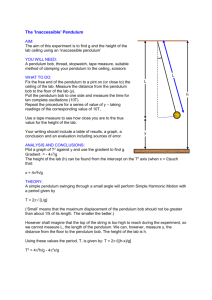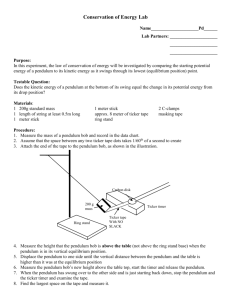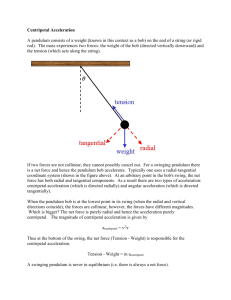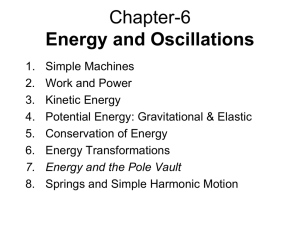Energy_and_Momentum2c - UCLA Physics & Astronomy
advertisement
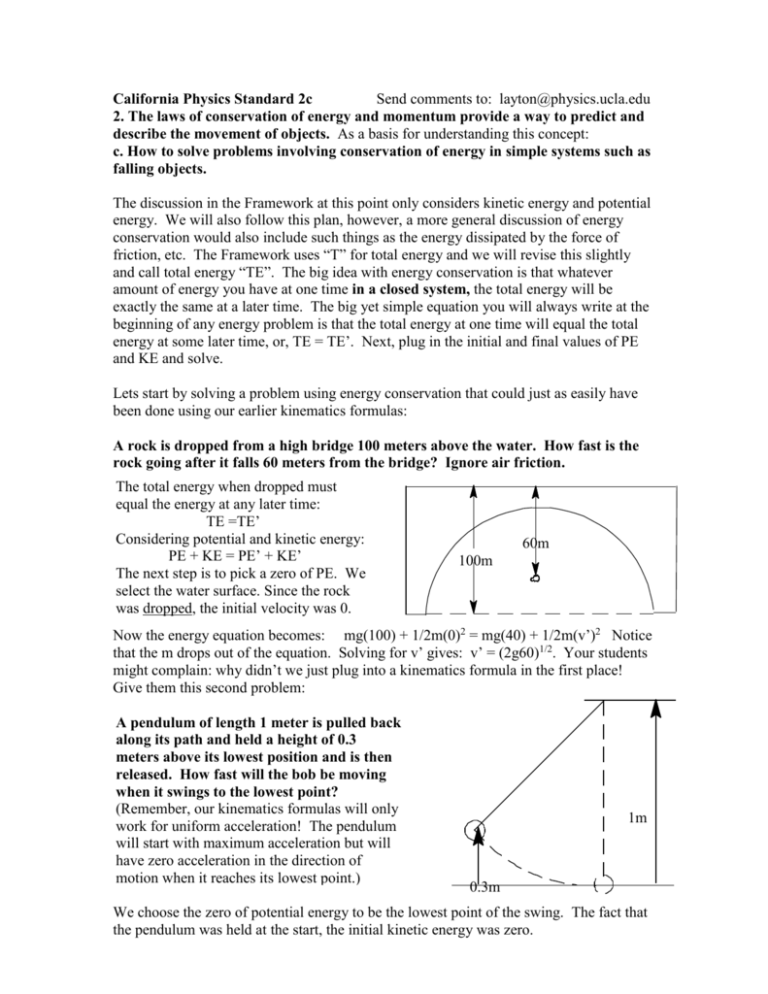
California Physics Standard 2c Send comments to: layton@physics.ucla.edu 2. The laws of conservation of energy and momentum provide a way to predict and describe the movement of objects. As a basis for understanding this concept: c. How to solve problems involving conservation of energy in simple systems such as falling objects. The discussion in the Framework at this point only considers kinetic energy and potential energy. We will also follow this plan, however, a more general discussion of energy conservation would also include such things as the energy dissipated by the force of friction, etc. The Framework uses “T” for total energy and we will revise this slightly and call total energy “TE”. The big idea with energy conservation is that whatever amount of energy you have at one time in a closed system, the total energy will be exactly the same at a later time. The big yet simple equation you will always write at the beginning of any energy problem is that the total energy at one time will equal the total energy at some later time, or, TE = TE’. Next, plug in the initial and final values of PE and KE and solve. Lets start by solving a problem using energy conservation that could just as easily have been done using our earlier kinematics formulas: A rock is dropped from a high bridge 100 meters above the water. How fast is the rock going after it falls 60 meters from the bridge? Ignore air friction. The total energy when dropped must equal the energy at any later time: TE =TE’ Considering potential and kinetic energy: PE + KE = PE’ + KE’ The next step is to pick a zero of PE. We select the water surface. Since the rock was dropped, the initial velocity was 0. 60m 100m Now the energy equation becomes: mg(100) + 1/2m(0)2 = mg(40) + 1/2m(v’)2 Notice that the m drops out of the equation. Solving for v’ gives: v’ = (2g60)1/2. Your students might complain: why didn’t we just plug into a kinematics formula in the first place! Give them this second problem: A pendulum of length 1 meter is pulled back along its path and held a height of 0.3 meters above its lowest position and is then released. How fast will the bob be moving when it swings to the lowest point? (Remember, our kinematics formulas will only work for uniform acceleration! The pendulum will start with maximum acceleration but will have zero acceleration in the direction of motion when it reaches its lowest point.) 1m 0.3m We choose the zero of potential energy to be the lowest point of the swing. The fact that the pendulum was held at the start, the initial kinetic energy was zero. TE =TE’ or, mgh + 1/2mv2 = mgh’ + 1/2m(v’)2 or, mg(0.3) +0 = 0 + 1/2m(v’)2 Again the masses drop out and we can solve for v’. Point out to your students that while the pendulum was swinging downward, the string was always exerting a force on the bob, but since this force was always at right angles to the direction of motion, it never did any work on the bob. An experiment to show Potential Energy being converted to Kinetic Energy. The idea behind this experiment is that a pendulum is elevated to a measured height and is released. When the bob reaches the lowest part of its swing, it is released and allowed to move as a projectile to strikes the floor some distance h away. The distance it freely falls vertically can be used to find the time of free fall and the distance it y moves horizontally can be use to find its horizontal velocity. With x this data the initial potential energy can be compared with the kinetic energy of the bob just as it separates from the string and begins to move as a projectile. One way to have the pendulum bob release at the lowest point of its swing is to bend a paper clip and attach it to the lower end of the string. Bend the clip so that it will have a long section pointing in a horizontal direction as illustrated on the left. Using a drilled pendulum bob, pass the horizontal section of the paper clip through the bob. This will support the bob during its downward swing but place a stop block that is firmly attached to the table exactly at the lowest point of the swing. This block will stop the paper clip and pendulum string but allow the pendulum bob to continue on in freely falling motion. (Some have used a sharp razor blade to cut the string at its lowest point but this will take some energy from the bob and requires retying after each run. Experiment to measure work to potential energy. A suggested experiment is to arrange a way to use a spring balance to measure the force required to pull a pendulum away from its rest position and record this force at several measured distances along its curved path. A graph of force vs. distance is made. The area of this graph could be determined by “square counting” (observing the proper unit value of each square). This area in joules should equal the value of mgh, where “h” is the vertical height of the bob for each position along the curved path.


